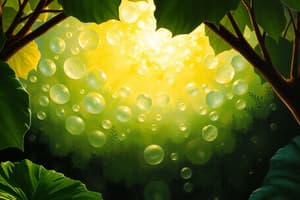Podcast
Questions and Answers
Which organelle is known as the 'powerhouse' of the cell?
Which organelle is known as the 'powerhouse' of the cell?
- Nucleus
- Mitochondria (correct)
- Chloroplast
- Cytoplasm
Which organelle houses the genetic material that controls the cell's functions?
Which organelle houses the genetic material that controls the cell's functions?
- Mitochondria
- Cytoplasm
- Endoplasmic Reticulum
- Nucleus (correct)
What is the function of the nuclear envelope?
What is the function of the nuclear envelope?
- Site of cellular metabolism
- Synthesis of proteins
- Energy generation
- Regulates movement of substances in and out of the nucleus (correct)
Which organelle provides a medium for the movement of materials within the cell?
Which organelle provides a medium for the movement of materials within the cell?
What is unique about mitochondrial DNA compared to nuclear DNA?
What is unique about mitochondrial DNA compared to nuclear DNA?
What is the primary function of mitochondria in a cell?
What is the primary function of mitochondria in a cell?
Which organelle is responsible for sorting, modifying, and secreting proteins and lipids?
Which organelle is responsible for sorting, modifying, and secreting proteins and lipids?
What is the function of peroxisomes in cellular metabolism?
What is the function of peroxisomes in cellular metabolism?
Which organelle contains enzymes responsible for breaking down waste materials and cellular debris?
Which organelle contains enzymes responsible for breaking down waste materials and cellular debris?
What role do cilia and flagella play in cells?
What role do cilia and flagella play in cells?
Which organelle is involved in the breakdown of fatty acids and generates hydrogen peroxide?
Which organelle is involved in the breakdown of fatty acids and generates hydrogen peroxide?
What is the function of the rough endoplasmic reticulum (ER)?
What is the function of the rough endoplasmic reticulum (ER)?
Flashcards are hidden until you start studying
Study Notes
Animal Cells: A Deep Dive into Organelles
Animal cells are the fundamental units of life, responsible for carrying out various functions in multicellular organisms. They are characterized by their eukaryotic nature, meaning they have a nucleus and other membrane-bound organelles. In this article, we will explore the various organelles found in animal cells and their roles.
Nucleus
The nucleus is the central organelle of cells, housing the chromatin and the nucleolus. It contains the genetic material, which controls the cell's functions and determines its characteristics. The nucleus is surrounded by the nuclear envelope, a double membrane that regulates the movement of substances in and out of the nucleus.
Cytoplasm
The cytoplasm is the jelly-like substance surrounding the nucleus and containing various organelles. It is the site of cellular metabolism and provides a medium for the movement of materials within the cell.
Mitochondria
Mitochondria are often referred to as the "powerhouses" of the cell. They generate most of the cell's energy in the form of ATP through a process called cellular respiration. Mitochondria have their own DNA, which is different from the nuclear DNA, and are believed to have originated from free-living bacteria that were engulfed by ancestral eukaryotic cells.
Endoplasmic Reticulum (ER)
The endoplasmic reticulum (ER) is a network of tubules that are responsible for protein synthesis, lipid synthesis, and the synthesis of carbohydrates. It is divided into two types: the rough ER, which has ribosomes attached to its surface, and the smooth ER, which does not.
Golgi Apparatus
The Golgi apparatus is responsible for sorting, modifying, and secreting proteins and lipids. It is a stack of flattened membrane-bound sacs that function as a sorting center for cellular components.
Ribosomes
Ribosomes are small, cytoplasmic organelles that play a crucial role in protein synthesis. They are composed of ribosomal RNA (rRNA) and proteins, and their structure is similar to that of a miniature factory.
Lysosomes
Lysosomes are membrane-bound organelles that contain digestive enzymes. They are responsible for breaking down waste materials, cellular debris, and foreign substances, such as bacteria, within the cell.
Peroxisomes
Peroxisomes are small organelles that play a role in cellular metabolism, specifically in the breakdown of fatty acids and the detoxification of certain substances. They contain enzymes that generate hydrogen peroxide, which is then broken down by the enzyme catalase.
Cilia and Flagella
Cilia and flagella are tiny, hair-like structures that extend from the cell surface. They play a role in cell motility and can be found in both prokaryotic and eukaryotic cells.
Centrosomes
The centrosome is a microtubule-organizing center that helps in the formation of the mitotic spindle, which is essential for cell division. It is also involved in the formation of the primary cilium.
Vacuoles
Vacuoles are membrane-bound organelles that store water, nutrients, and waste products. They are particularly prominent in plant cells, where they often take up a large portion of the cell.
Cell Wall (in some animal cells)
Some animal cells, such as those of insects and fungi, have a cell wall surrounding their plasma membrane. The cell wall provides structural support and helps the cell withstand osmotic pressure. It is composed of various polysaccharides, such as chitin in insects and glucans in fungi.
Each of these organelles plays a crucial role in the proper functioning of animal cells. Understanding their structure and function is essential for grasping the intricacies of cellular biology.
Studying That Suits You
Use AI to generate personalized quizzes and flashcards to suit your learning preferences.




